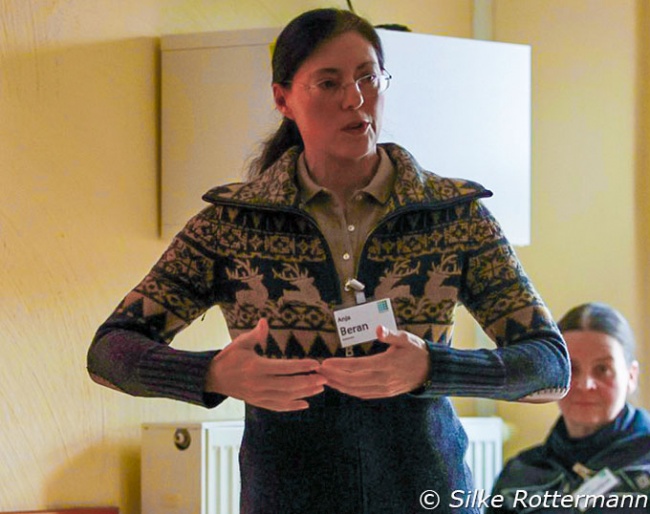
This article is a continuation of Today for Tomorrow - A Weekend Dedicated to Good Equestrian Sport at the 2024 Burgtagung and "Everything Was Better in the Past, Wasn’t It?"
-- Text and Photos © Silke Rottermann for Eurodressage
With 20 short seminars on Saturday and 10 on Sunday, the Burgtagung was action packed. On Saturday afternoon I was in a quandary: Uta Gräf’s lecture "Time factors in horse training" and Anja Beran’s "Eye schooling" lecture ran simultaneously and both seemed super interesting to attend.
Finally and after much soul searching I decided for Beran as this topic seemed even more important because it is exactly the getting used to totally wrong pictures at all frontiers which endangers dressage competitions in our days.
Anja Beran: "Schooling The Eye"
When renowned equine osteotherapist Stefan Stammer, former I-judge Angelika Frömming, fellow Eurodressage author and trainer Niina Kirjorinne and I entered the seminar room about 20 minutes before the lecture was about to start, the room was already pretty crowded and it became totally stuffed with extra chairs and people even standing until Anja Beran started her lecture.
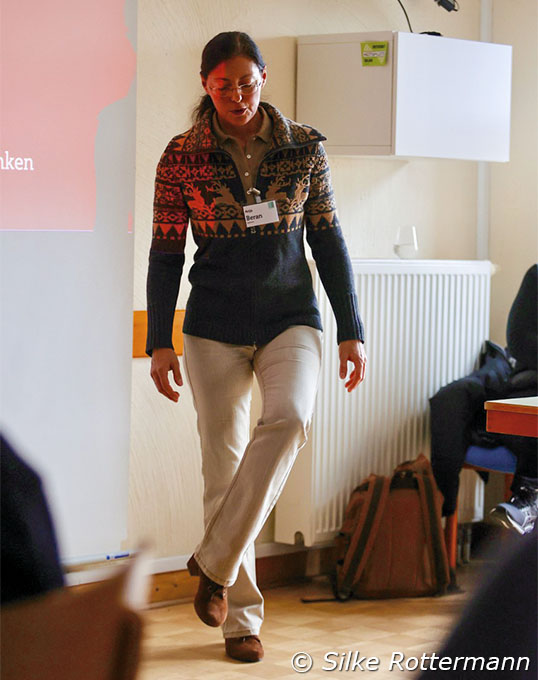
I frankly admit that I am pretty skeptical towards certain "classical alternatives" which sprang up like mushrooms during the past, let’s say 20 years, and of which some seem as detrimental to a horse than the totally rightly condemned hyperflexion / rollkur stuff which a renowned trainer once called "the cancer of equitation" in a conversation with me. Many of these riders / trainers seem to built their flourishing business on the excesses of dressage competition. By loudly and sometimes polemically downgrading it they attract riders who are long disappointed about the way dressage competition has been going over the past decades.
The reason why I felt like I had to listen to Anja Beran’s lecture is that I never had this skepticism about her as a person or her work. Her displays in the famous Circus Krone in Munich (for which she trains horses), her seminars at the Marbach State Stud, her books and her articles reveal a sound training based on classical principles common of the German and French school which I both got to know over the past 25 years. The fact that Beran trains an amazing variety of horse breeds and types at her Rosenhof facility in Bavaria is the proof in the pudding that correct work enables less talented horses, compared to the modern warmblood with breathtaking gaits, learn High School movements and to keep their bodies healthy over a long period of time.
Finally The Full Lecture
Beran’s lecture „Schooling the eye“ has been around since 2017, but I confess I have only seen snippets of it until the Burgtaging on 10 February 2024. I had no real clue what awaited us.
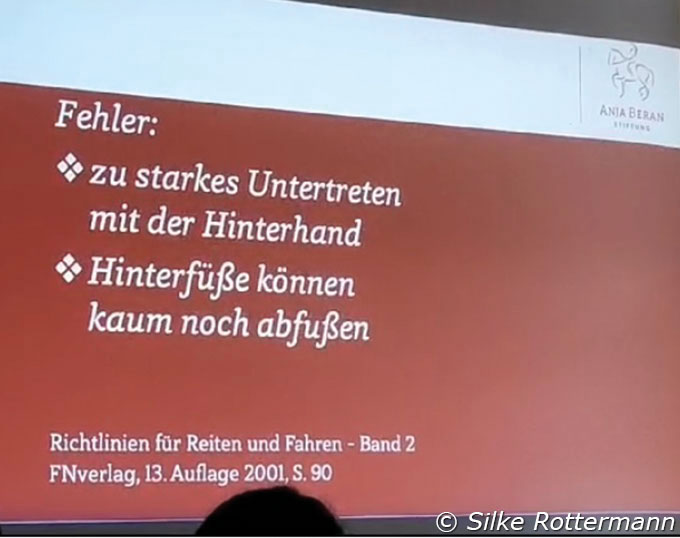
Beran, who spoke calmly and clearly throughout her lecture, was refreshing to listen to as there was absolutely no polemic in her words, there was no attack on the German guidelines. On t-he contrary, she clearly values them in their content or there was never a a general questioning of the purpose and manner dressage competition are held as such. Instead she revealed the big and ever growing gap between the aspirations expressed in these guidelines and the too often sad reality in our days.
The basis of her whole analysis were exactly these famous German guidelines, but Beran also repeatedly quoted from Dr. Udo Bürger’s books from the 1950s, which are perhaps some of the best existing and very worth-reading manuscripts, describing the many problems of today which already existed back then.
The wrong track begins from early on
Beran stressed that during the training of horses the time factor is not allowed to play any role ("We are not in war times!"), but due to commercialism of the sport the time factor plays a role and as a consequence the correct training suffers from the beginning, with the horses suffering mental and physical damages which requires a lot of time and effort to be corrected.
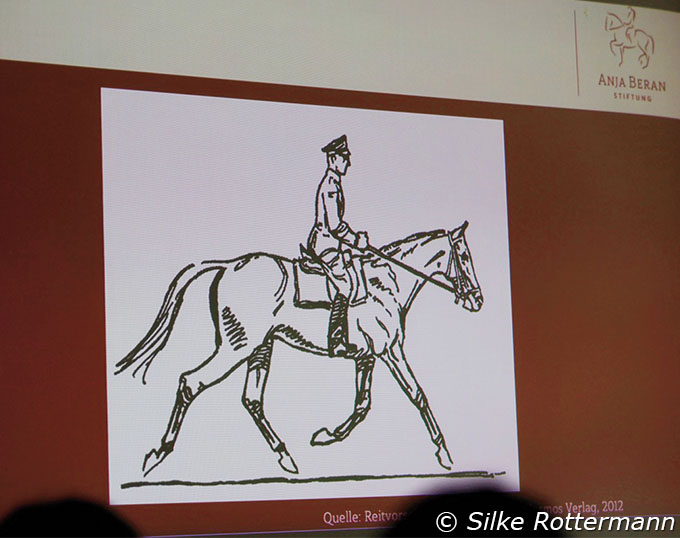
By showing a drawing from the German cavalry manual she visualized the frame in which she would like to see a young horse: "The neck does what the hindquarters indicate, the rider does not form the neck, but it remains long so that the horse can use it as a balancing prod. Nowadays the neck is often manipulated by the rider. But if you try to already form a very young horse, you get a slow-down-effect and as a consequence I need to make more pressure with my legs."
The result Beran showed in an animated trick film in which two horses trotted, one in a correct open frame in a horizontal balance and another already being overbent and on the forehand.
I am sure I wasn’t the only one who promptly thought that the correctly moving horse would stand a bad chance at a young horse competition and would be called "not on the bit". That certainly explains why the wrong horse wins nowadays over the correct beginning with young horses. Beran added the anecdote of a 3-year old warmblood stallion whom she got after the licensing. He had been lunged with standing side-reins and hid behind the vertical. The neck got a wrong outline which now needed to be corrected.
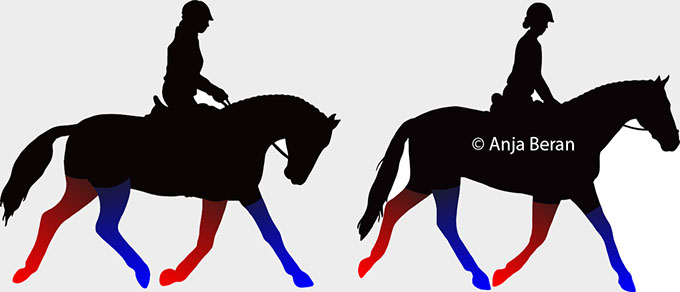
Trotting a young horse
"When the breeder saw his stallion for the first time again, he liked how relaxed he went and that the wrong outline had disappeared, but at the same time he said he cannot sell the horse like that because he did not go on the bit," Beran reported and added that the horse is not on the bit either if it evadesg the contact by hiding behind the vertical. That wrongly presented picture seems widely accepted nowadays.
What Has Happened To The Three Ps?
Beran is not the first and will certainly not be the last who attempts to be an eye-opener for hopefully a huge number of riders by showing what is right and wrong.
She showed photos with horse and rider blackened depicting how it "should not be done" yet the dressage fan immediately recognized which combinations were being used. Beran chose a different and much more graphic way by showing animated trick films, hence the horse in movement which is much more educational than looking at the infamous "moments in time" photos. These films are based on real film clips and the experienced dressage fan could easily recognize the faulty movement patterns, typical for certain horses in international sport.
Whereas the right and the faulty movements were first shown on its own, they were then put face to face which was very interesting thing to see.
Passage
One of the most striking differences when watching videos from the 1980s or 1990s compared to how the passage is executed nowadays.
Perhaps less spectacular looking back then, in the prime examples the movement was going through the whole horse’s body whereas today we can often see braced backs and pulled up legs, creating a kind of artificial suspension phase during which the horse seems to work extremely hard instead of creating the impression of an effortless floating.
While this is obvious to the attentive onlooker, the making of such a passage was illustratively explained by Anja Beran who stressed that this is only possible because the modern horses have a very good mechanic in their gaits and a high level of energy which both come into use.
"An artificial suspension phase is created by immense pressure and by using the game 'hand against leg and vice versa.' In this game the leg has to win, the rider stabs behind and holds in front. Such kind of passage is based on a longer uphold of the legs and not because the horse goes energetically upwards from lowered haunches and moves slowly forward in the air before softly putting the legs down again. Instead the back is often hollowed, the legs are each pulled upwards and the hind-legs are unable to follow the exaggerated front-leg action because the hollowed back," Beran explained.
Her animations then showed the different variations of this fake passage, with legs twitching or oscillating or circling, or in worst case even bouncing to hold the balance. It was painful to watch some of the most famous dressage horses, made neutral in black in Beran's animations, to be used as examples of an incorrect, high scoring passage.
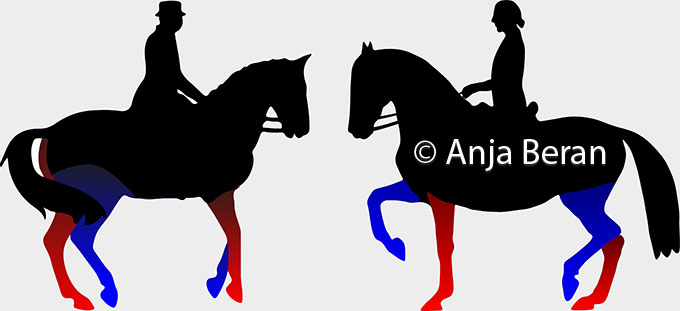
Piaffe
"The piaffe is no final goal, but gymnastics for the horse’s back and hindquarters," Beran underlined and made clear that "all horses can learn it because it is within their natural range of movements, although not all manage to show a moment of suspension."
In the animated films that followed, showing the whole variety from a perfect piaffe to different forms of faults, it was important for Beran to make a distinction between "no piaffes" and "faulty piaffes" For her only a diagonal movement can be called piaffe, whereas attempts in which the horse looses the two-beat-rhythm shouldn't even be considered a piaffe.
I was just tempted to think "if only the judges would follow this thinking," when former I-judge Angelika Frömming interposed that today horses often do not show a clear diagonal and still get high marks, prompting Beran to sigh "That is exactly the problem!"
She continued by ascertaining that the horses are often on the forehand in piaffe, showing that the horses are badly prepared in that they are not gymnasticized and therefore not collected. A horse which is asked to piaffe, but is unable to lower the haunches, somehow moves in place because it is hindered by the curb action to go forward. This usually ends in a horse somehow lifting his legs, for example swinging with the hind-legs from side to side as it has not learnt to take weight, or the horse sways in front with wide front-legs („balancé“).
Pirouettes
We all know these pictures in which we get the impression the horse is about to take off because the front-legs climb highly like in slow-motion during a canter-pirouette. It might be impressive, but "good pirouettes are unspectacular. Reared-up pirouettes get high marks because the misconception dominates that a horse who climbs up is sitting on the hindquarters." In reality these horses are not coming up in front because their hindquarters are lowered, but because they brace their backs and their hindquarters are stiff.
Beran confessed that this is not easy to recognize and requires a well-schooled eye, but shouldn’t we expect exactly this from the judges at the highest level?
Trot Extensions
Perhaps easier to recognize for the less schooled eye is a wrong trot extension as the extreme front-leg action and broken diagonals are very apparent to onlookers.
Beran’s animations showed clearly what happens when a rider drives a horse with water-skiing seat and legs against a fixed hand: The front-legs are thrown, one hind-leg pulled up, but not stepping under (the hollowed back prevents that) while the other is out behind. The whole horse is put under enormous tension. Because the front legs get more stretched than the hind legs can generate thrust, the front leg is unable to touch down where it points to. As a result it needs to be slightly pulled back before it touches down, which is completely unnatural.
Beran remarked that some extended trots remind her of the movement of "Spanish Trot." This is a movement sometimes to be seen in the circus in which the diagonal is broken because of the raised frontlegs. However, in a good Spanish trot the horse is clearly carrying himself and is not restricted by harsh hands.
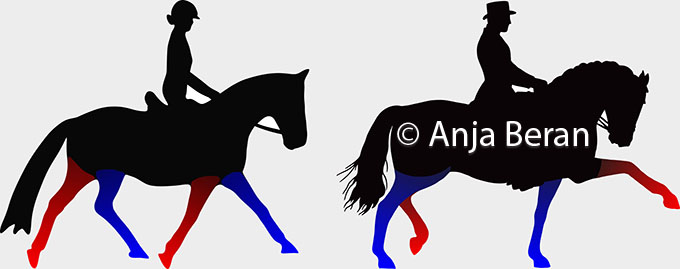
It is 5 past 12
Anja Beran concluded her lecture with the statement that the „general direction is totally wrong at the moment." The training is too often shortened and adapted to the goal of generating "spectacular" movements, leading to incorrect movements with often serious consequences for the horse’s health.
That these incorrect movements get rewarded with high marks has become incompatible with the German guidelines and the classical principles, leaving a big question mark over the future of dressage competition. Dressage is a discipline - I want to remind all readers - which was once founded by the FEI "in 1929 in order to preserve the Equestrian Art from the abuses to which it can be exposed and preserve it in the purity of its principles." (See article 419 of the old FEI dressage rule-book). We have to preserve what the FEI called "Object of international dressage events" slowly nowadays!
Beran’s matter-of-fact, well structured and visualized lecture earned her a long and thunderous applause, but also very pensive faces. Stefan Stammer probably expressed exactly what many felt when he remarked "A sensational lecture. Training always has to be based on muscular development."
Soon coming about Burgtagung conference:
Anja Beran and Uta Gräf: Fair and delightful dressage training